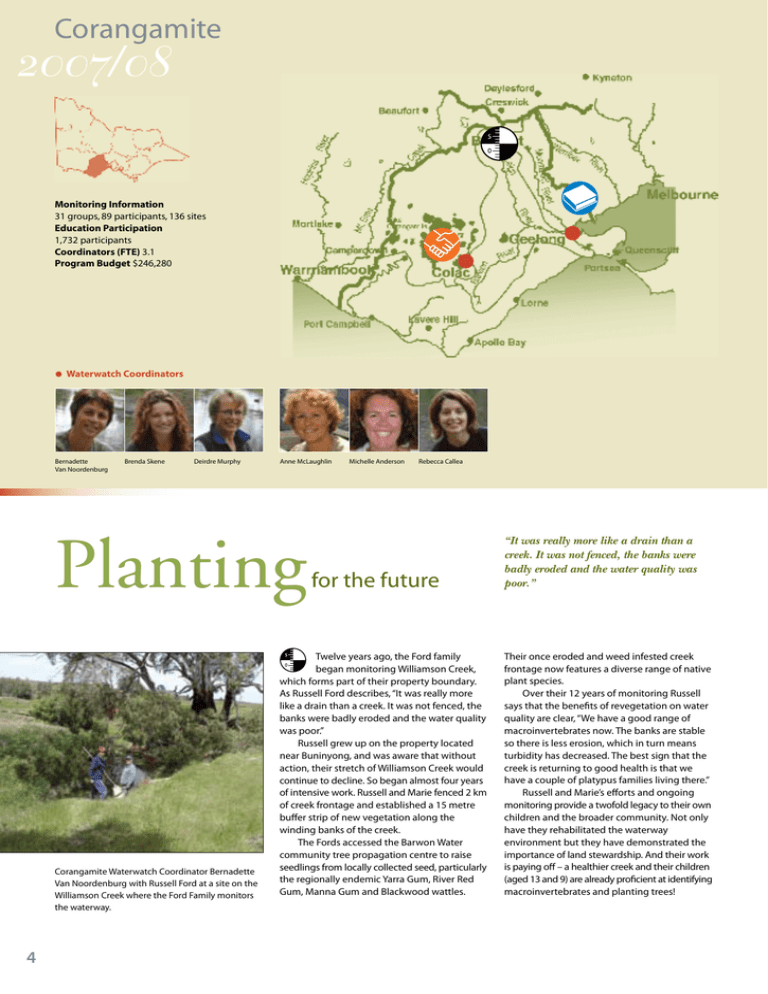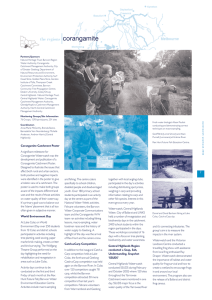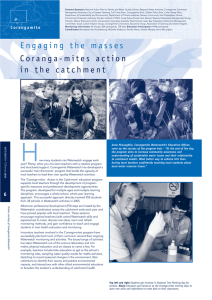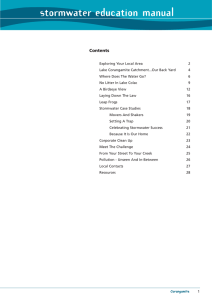Planting 2007/08 Corangamite •
advertisement

Corangamite 2007/08 Monitoring Information 31 groups, 89 participants, 136 sites Education Participation 1,732 participants Coordinators (FTE) 3.1 Program Budget $246,280 • Waterwatch Coordinators Bernadette Van Noordenburg Brenda Skene Deirdre Murphy Anne McLaughlin Planting Corangamite Waterwatch Coordinator Bernadette Van Noordenburg with Russell Ford at a site on the Williamson Creek where the Ford Family monitors the waterway. 4 Michelle Anderson Rebecca Callea for the future Twelve years ago, the Ford family began monitoring Williamson Creek, which forms part of their property boundary. As Russell Ford describes, “It was really more like a drain than a creek. It was not fenced, the banks were badly eroded and the water quality was poor.” Russell grew up on the property located near Buninyong, and was aware that without action, their stretch of Williamson Creek would continue to decline. So began almost four years of intensive work. Russell and Marie fenced 2 km of creek frontage and established a 15 metre buffer strip of new vegetation along the winding banks of the creek. The Fords accessed the Barwon Water community tree propagation centre to raise seedlings from locally collected seed, particularly the regionally endemic Yarra Gum, River Red Gum, Manna Gum and Blackwood wattles. “It was really more like a drain than a creek. It was not fenced, the banks were badly eroded and the water quality was poor.” Their once eroded and weed infested creek frontage now features a diverse range of native plant species. Over their 12 years of monitoring Russell says that the benefits of revegetation on water quality are clear, “We have a good range of macroinvertebrates now. The banks are stable so there is less erosion, which in turn means turbidity has decreased. The best sign that the creek is returning to good health is that we have a couple of platypus families living there.” Russell and Marie’s efforts and ongoing monitoring provide a twofold legacy to their own children and the broader community. Not only have they rehabilitated the waterway environment but they have demonstrated the importance of land stewardship. And their work is paying off – a healthier creek and their children (aged 13 and 9) are already proficient at identifying macroinvertebrates and planting trees! Network monitors the Lake Colac is an important environmental and recreational asset to the township of Colac. However, years of drought have taken their toll on the scenic Lake. In recent times, the turbid water and death of fish have been of great concern to local residents and the Colac Otway Shire. Local Waterwatch Facilitator, Brenda Skene, said, “We had carp fish dying because of the high salinity levels and low water levels in the Lake. If hardy carp can’t even survive then you have to wonder what other species, particularly native species, have also been lost.” Encouraged by the Colac Otway Shire and supported by Corangamite Waterwatch, a group of people came together to form a monitoring network. Representing a range of stakeholder and interest groups, including Landcare, the Alvie Tree Planters and existing Waterwatch monitors, the network’s monitoring results are being coordinated to provide a detailed picture of the water quality in the numerous creeks and drains that flow into Lake Colac. inflow As Neil McInnes of the Upper Barwon Landcare Network describes, “The Lake Colac Catchment project members monitor at 17 sites along creeks and drains upstream of Colac. By monitoring creeks and drains at numerous points along their course, you can get a good idea of where sediments and nutrients are entering the system.” The monitoring network covers all the creeks and drains entering Lake Colac and by doing so aims to identify water quality problems, the sources of pollutants and ultimately to undertake community-led action to improve the waterways. For example, the recent installation of litter traps on one stormwater drain entering the Lake and the extensive fencing and revegetation works along Deans and Barongarook Creeks by the Upper Barwon Landcare Network will reduce the nutrient and sediment load entering Lake Colac. Works such as these have both immediate and long term benefits for the health of Lake Colac and will ultimately restore water quality. The Lara Primary School students wading in Lake Serendip. “We are teaching our students to be scientists. It’s not just dipping a bucket into water, but doing it correctly and using effective method.” Members of the Lake Colac monitoring network at Delaney’s Reserve. “By monitoring creeks and drains at numerous points along their course, you can get a good idea of where sediments and nutrients are entering the system.” classroom is a sanctuary In changing times, a savvy school combines environmental studies with information technologies. With the beautiful You Yangs Regional Park as a backdrop and Lake Serendip at their doorstep, it is no surprise that students at Lara Primary School participate in a very special environmental studies program. In fact, Lara Primary School has established an ‘Environmental Multimedia Learning Centre’ at the Sanctuary, where students of all levels participate in week-long classes. Whilst some time is spent in the purposebuilt classroom learning about topics ranging from bird identification and brolgas to plant propagation, a highlight for the students is putting on the waders and getting in the water. As local Waterwatch Education Officer Rebecca Callea describes, “The main focus of the program at Lake Serendip is biological. We sample macro-invertebrates from different parts of the Lake and look at them as indicators of water quality.” The aim of the subject, ‘Serendip Environmental Multimedia’ is threefold – to teach about the environment, to use information technologies to inform others, and for students to take responsibility for their own behaviour. Their Waterwatch activities allow them to do all three things. As Marcia O’Brien, the coordinating teacher at Lara Primary School describes, “We are teaching our students to be scientists. It’s not just dipping a bucket into water, but doing it correctly and using effective method. They then report their findings, using programs like Flash, film or slideshows.” Finally, the students are responsible for their learning environment and have to follow safety protocols, do all the cleaning of the classroom and facilities and care of their equipment, particularly hanging up the prized waders to dry! Rebecca attributes the success of the class to the fact that many organisations and individuals, including Parks Victoria and Waterwatch, contribute to the program – “Different people inspire the students for different reasons, but there is something in there to excite everyone.” Partners and Sponsors of the Corangamite Waterwatch Program National Action Plan for Salinity and Water Quality, Barwon Water, Corangamite Catchment Management Authority, City of Greater Geelong, Central Highlands Water, Colac Otway Shire, Corangamite Connections Environmental Educators Group, Leigh Catchment Group. 5




